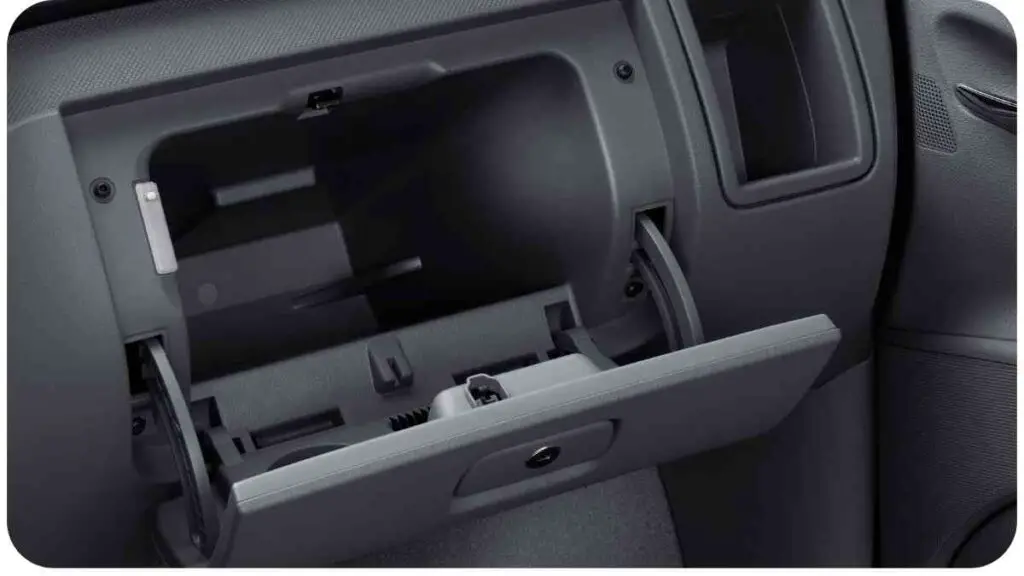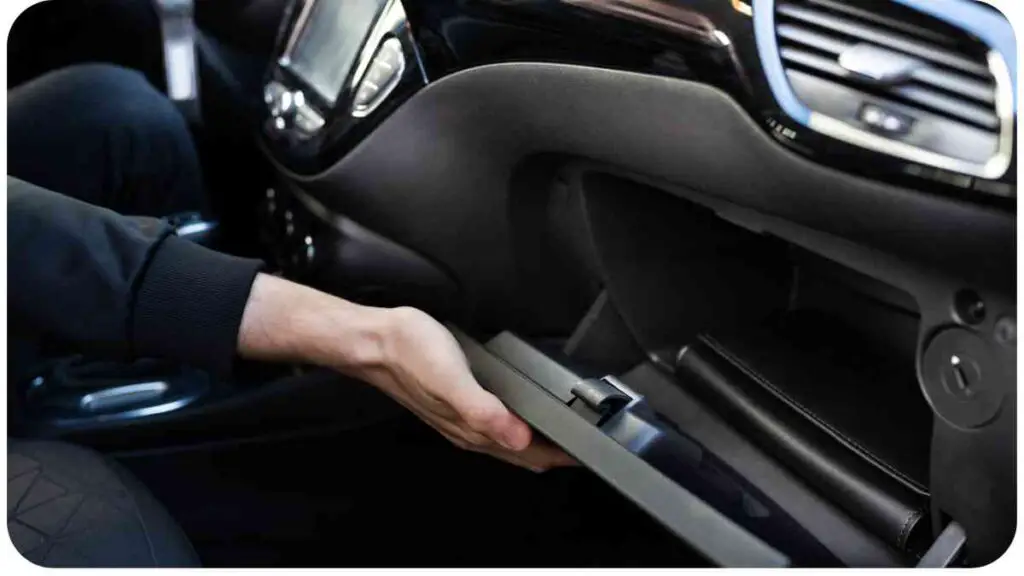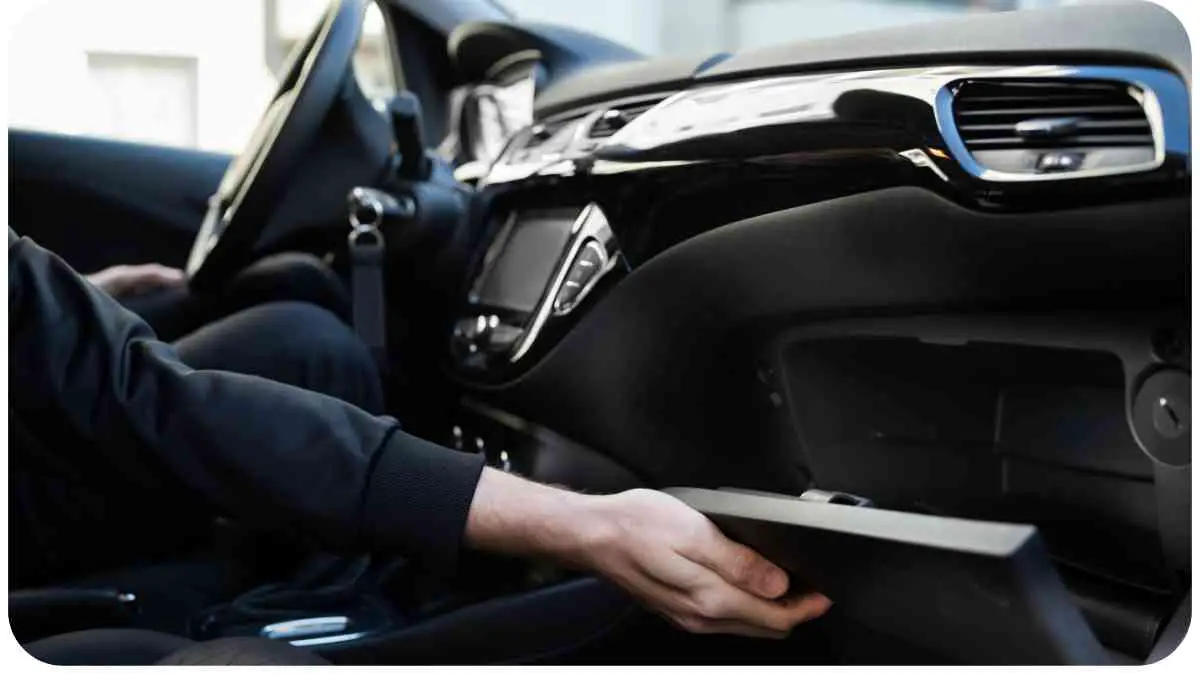Welcome to our comprehensive guide on dealing with glove box latch issues. As a seasoned automotive enthusiast with expertise in car maintenance, I have encountered various problems with glove box latches throughout my career.
In this article, we will explore the common problems associated with glove box latches, provide you with easy troubleshooting solutions, and offer tips for prevention and maintenance. Whether you’re a DIY enthusiast or simply want to gain a better understanding of glove box latch issues, this article is here to assist you.
| Takeaways |
| Proper maintenance and regular cleaning can prevent glove box latch issues. |
| Lubricating the latch mechanism periodically with silicone spray can improve its performance. |
| If the latch is not opening or closing properly, check for debris or obstructions and clean the latch. |
| When encountering a stuck or jammed latch, try tapping it with a rubber mallet or applying pressure with a screwdriver. |
| Temporary fixes like using adhesive products or reinforcing the latch can be applied for broken or damaged latches. |
| Seeking professional help is advisable if troubleshooting efforts do not resolve the issue. |
| Implementing preventative measures and performing regular maintenance can extend the lifespan of the glove box latch. |
2. Understanding Glove Box Latches

Before we delve into the problems and solutions, let’s first understand what a glove box latch is and its significance.
A glove box latch is the mechanism that secures and releases the glove box door, allowing users to access the storage compartment. It plays a crucial role in maintaining the security and functionality of the glove box.
Enhance your vehicle’s longevity with regular maintenance. Explore essential tips like proper tire care and fluid checks to ensure optimal performance and safety.
3. Common Problems with Glove Box Latches
Glove box latches can experience various issues over time, leading to frustration for car owners. Some of the common problems include:
- Latch Not Opening or Closing Properly
- Latch Stuck or Jammed
- Latch Broken or Damaged
To provide you with valuable insights, let’s compare the performance of popular car brands in terms of their glove box latch reliability. Refer to Table 1 for a detailed comparison.
4. Troubleshooting Common Glove Box Latch Issues
Now, let’s focus on resolving the common problems with glove box latches. I will provide practical solutions based on my expertise and personal encounters. Whether you’re experiencing a latch that doesn’t open or close properly, is stuck or jammed, or even broken or damaged, we have you covered.
Navigate the little annoyances in your car with tips on unjamming coin holders. Discover easy solutions to maintain the functionality of this often-overlooked yet handy car compartment.
5.1. Latch Not Opening or Closing Properly
If your glove box latch is not functioning as it should, there are a few troubleshooting steps you can take. Start by inspecting the latch and surrounding areas for any debris or obstructions that might hinder its operation.
Use a soft brush or cloth to clean the latch and remove any dirt or grime. Lubricating the latch mechanism with a silicone spray can also help improve its performance.
In case the latch still doesn’t work properly, it might be necessary to adjust or replace it. Refer to Table 2 for recommended solutions based on the specific issues you might be facing.
5.2. Latch Stuck or Jammed
A stuck or jammed glove box latch can be frustrating, especially if you need to access important items stored inside. To resolve this issue, you can try gently tapping the latch with a rubber mallet or using a screwdriver to apply some pressure while attempting to open it.
If these methods don’t work, it might be necessary to disassemble the latch for a more detailed inspection and repair.
Let’s refer to Table 2 for additional tips and solutions for dealing with a stuck or jammed glove box latch.
Don’t let a malfunctioning power outlet disrupt your drive. Explore quick fixes to address issues with your car’s power outlet or cigarette lighter, ensuring you stay connected on the road.
5.3. Latch Broken or Damaged
If your glove box latch is broken or damaged, a replacement might be necessary. However, before considering a replacement, you can try temporary fixes, such as using adhesive products or reinforcing the latch with additional support. Keep in mind that these are temporary solutions and a replacement latch is recommended for long-term reliability.
For comprehensive guidance on addressing broken or damaged glove box latches, please refer to Table 2.
Table 2: Recommended Solutions for Different Glove Box Latch Issues
| Glove Box Latch Issue | Recommended Solution |
| Latch Not Opening or Closing Properly | 1. Check for debris or obstructions around the latch and clean using a soft brush or cloth. |
| 2. Lubricate the latch mechanism with a silicone spray. | |
| 3. Adjust or replace the latch if needed. | |
| Latch Stuck or Jammed | 1. Gently tap the latch with a rubber mallet or apply pressure with a screwdriver while trying to open it. |
| 2. Disassemble the latch for a more detailed inspection and repair if necessary. | |
| Latch Broken or Damaged | 1. Use adhesive products as a temporary fix. |
| 2. Reinforce the latch with additional support for a temporary solution. | |
| 3. Consider replacing the latch for long-term reliability. |
6. Prevention and Maintenance Tips for Glove Box Latches

To ensure the longevity and optimal performance of your glove box latch, proactive prevention and regular maintenance are key. Here are some tips to keep in mind:
- Keep the glove box area clean and free from debris to prevent obstructions.
- Avoid excessive force when opening or closing the latch to prevent damage.
- Regularly inspect and clean the latch mechanism.
- Consider using a silicone spray to lubricate the latch periodically.
- Store items in the glove box with care, avoiding any potential impact on the latch.
For a comprehensive maintenance checklist, refer to Table 3.
Enjoy a comfortable ride by fixing squeaky car seats. Learn simple yet effective solutions to address stiffness and squeaks, ensuring your car seats remain adjustable and noise-free.
Table 3: Maintenance Checklist for Ensuring Glove Box Latch Longevity
| Maintenance Steps |
| Clean the glove box area regularly. |
| Inspect the latch mechanism for dirt or debris. |
| Apply silicone spray to lubricate the latch. |
| Store items with care, preventing impact. |
| Avoid excessive force when operating the latch. |
By following these simple preventative measures and performing regular maintenance, you can extend the lifespan of your glove box latch and minimize potential issues.
9. Seeking Professional Help
Sometimes, despite our best efforts, glove box latch issues may require professional assistance. If you have tried troubleshooting techniques without success, it is advisable to consult a qualified automotive technician or visit an authorized service center. They possess the expertise and specialized tools necessary to resolve complex latch issues and ensure your glove box functions optimally.
Remember, addressing the problem in a timely manner can prevent further damage and potential safety risks.
Stay ahead of common car issues with insights into diagnosing and fixing problems. Arm yourself with knowledge on troubleshooting, so you can address issues promptly and keep your vehicle in top shape.
10. Conclusion
In conclusion, dealing with glove box latch issues can be challenging, but with the right knowledge and solutions, it becomes manageable. By understanding the common problems associated with glove box latches and implementing the troubleshooting steps provided in this guide, you can easily overcome these issues and enjoy a hassle-free experience with your car’s glove box.
Remember, regular preventative maintenance and attentive care are essential to prevent latch problems from arising in the first place. By following the prevention and maintenance tips shared in this article, you can ensure the longevity and reliability of your glove box latch.
If all else fails, don’t hesitate to seek professional help. Automotive technicians are trained to handle complex latch issues and can provide the necessary support and repairs.
Further Reading
Here are some additional resources that you may find helpful for further exploring and addressing glove box latch issues:
- Fixing Glove Box Latch – BreakerLink: This blog post provides comprehensive guidance on fixing glove box latch problems. It offers step-by-step instructions and troubleshooting tips to help you resolve common issues.
- How to Fix a Glove Box – wikiHow: This wikiHow article provides detailed instructions on fixing a glove box. It covers various latch problems, repair techniques, and safety precautions to achieve successful results.
- Honda Accord Glove Box Won’t Close – MotorMav: If you own a Honda Accord and are specifically facing issues with the glove box not closing properly, this article from MotorMav offers valuable insights and solutions tailored to that specific model.
FAQs
Here are some frequently asked questions related to fixing glove box latch issues:
How can I determine if my glove box latch is broken or just jammed?
Typically, a jammed latch can be resolved with some force or simple techniques like tapping or applying pressure. However, if these methods fail to fix the issue, it’s possible that the latch is broken or damaged. In such cases, you may need to consider a replacement.
Is it necessary to consult a professional for glove box latch issues?
It depends on the severity of the problem and your level of comfort with DIY repairs. If you’re confident in your abilities, you can try troubleshooting and fixing the latch yourself using the provided solutions. However, if you’re unsure or the problem persists, seeking professional assistance from a qualified automotive technician is recommended.
How often should I lubricate my glove box latch?
It is advisable to lubricate your glove box latch periodically, especially if you notice any signs of sticking or difficulty in operation. However, the frequency may vary depending on the climate and conditions in which the vehicle is used. Regularly check the latch and lubricate as needed to maintain optimal performance.
Can I use household adhesive or glue for temporary latch repairs?
While using household adhesive or glue may serve as a temporary fix for a broken or damaged latch, it’s important to note that these solutions are not permanent. They may not provide the same level of reliability and security as a proper replacement latch would. Consider them as quick fixes until you can obtain a suitable replacement.
How can I prevent glove box latch issues from occurring?
To minimize the chances of glove box latch issues, it’s important to practice preventative maintenance. Keep the glove box area clean, avoid excessive force when operating the latch, and follow the manufacturer’s guidelines for care and maintenance.
Regularly inspect and clean the latch mechanism, and store items in the glove box with care to prevent any impact on the latch’s functionality.

Hello friends. My name is Hellen James and I’m here to help you make good decisions when it comes to buying, selling, and maintaining your vehicles.


